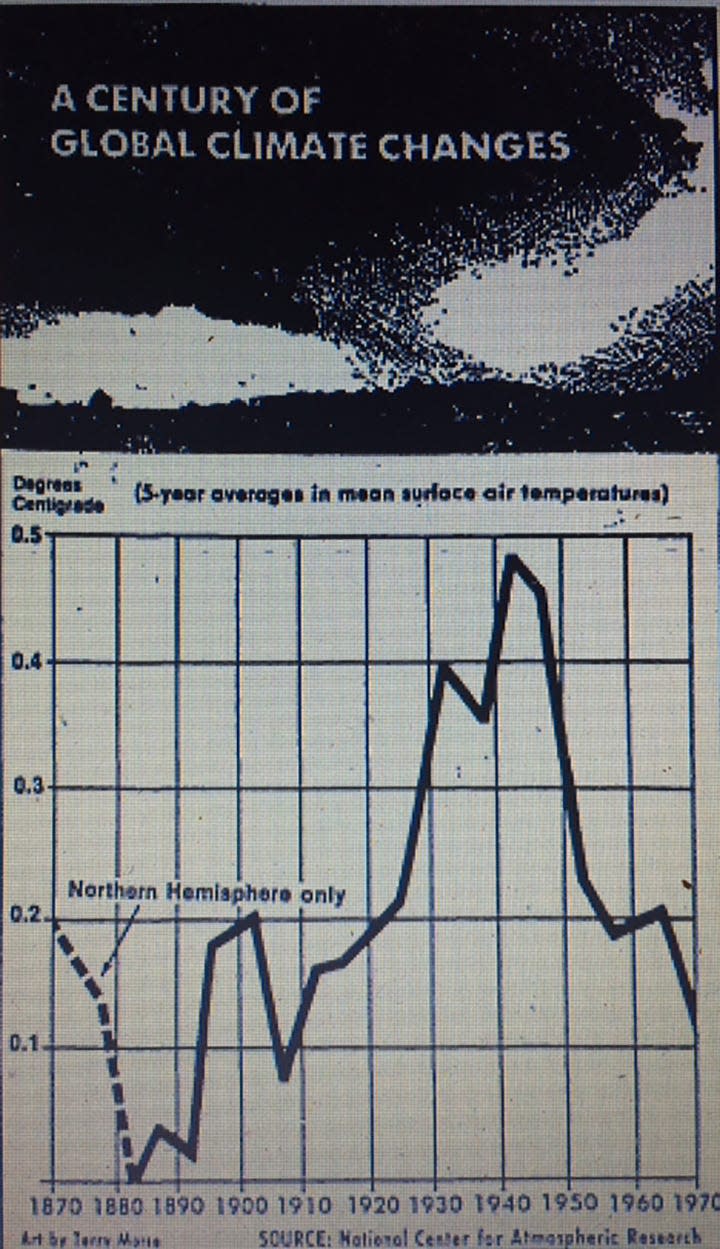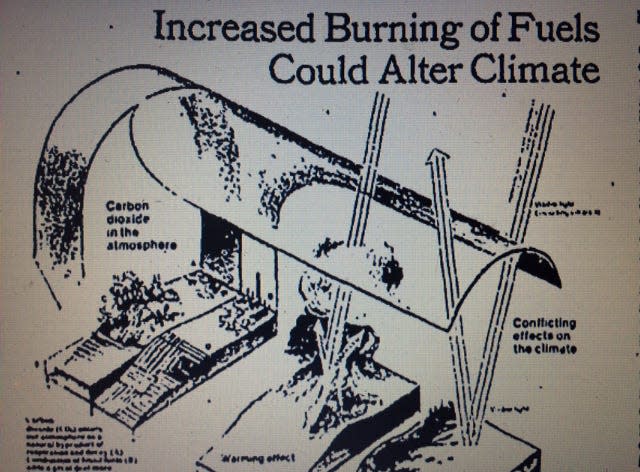The Monday After: Getting historical perspective on climate change

Climate change has been one of the most debated environmental issues in the world during recent years.
In Canton it isn't a new discussion.
Articles about the changing climate have been printed on pages of The Canton Repository for nearly its entire history, stretching back more than two centuries to the days when it was a weekly publication printed under the name The Ohio Repository.
Reports didn't always center on "global warming."
"Has the earth changed its axis and its poles?" asked an article from the Weekly Recorder, datelined Circleville, Ohio, and republished in the Repository on the front page of its July 13, 1820, issue. "Or has an accumulation of ice within the polar circles produced a change in our once mild climate?"
"If this climate has been growing colder during three centuries in the same ratio it has within the last thirty years, we need not look further for a cause than the greater prevalence of that current of air rushing across our inland seas, Erie, Michigan,Huron, Superior, etc, from the regions of perennial frost."

Finding warmth in the world
A more in-depth investigation into climate change published in the July 3, 1845, issue of the Repository began to focus on global warming in a manner that made it appear this wasn't a new observation.
"The extraordinary change of climate, at periods of long duration, has been observed and commented on, and wondered at, by everyone who has paid the least attention to the subject," the article began. "It is a general subject of remark, in this part of the country that our winters are now much milder than formerly. In the recollection of many of our citizens, our rivers used to be regularly frozen over, so that they could be crossed by a six-horse team, and good sleighing was an annual enjoyment.
"Now it is rarely that rivers are frozen sufficiently hard to be crossed with safety, and sleighing has become almost obsolete."
The world climate was being altered, as well, although not necessarily warming, the article noted. The reason was the changing of the revolutions of the magnetic poles.
"The cold is consequently increasing in Europe, and the heat increasing in this country, east of Pittsburgh."
Other causes were discussed
The theory that the variation of the paths of the magnetic poles caused changes in temperatire in the world again was cited in a Scientific American article republished in the Repository on March 28, 1855, noting that "history informs us that many of the countries of Europe which now possess very mild winters at one time experienced severe cold during this season of the year."
The article debunked another theory.
"Some have ascribed these climate changes to agriculture, the cutting down of dense forests, the exposure of the upturned soil to the summer's sun, and the draining of great marshes," the article said. "We do not believe that such great changes could have been produced on the climate of any country by agriculture."
An article published in the Repository on Dec. 1, 1876, identified another possible cause, citing research by a researcher who predicted a colder climate was in store for Europe following the proposed "piercing of the Isthmus of Suez."
That researcher, explained the article, "says Europe owes its moderate climate partly to the warm water heating by the Gulf Stream partly to the hot air heating by the wind from the African desert (Sahara)."
Modern science saw drastic changes
The 20th century – beginning in earnest in the 1970s through the 1990s – brought a greater concern for changes in the climate.
"Around the world warning signs raise an insistent alarm – earth's climate is changing, quickly and perhaps forebodingly," began a Christian Science Monitor New Service article by David F. Salisbury published in the Repository on Sept. 2, 1974.
The article published the unanimous verdict of climate experts who had gathered in Bonn, Germany, earlier that year.
"The studies of many scholars, attest that a new climatic pattern is now emerging," a statement by that group had said. "We believe this climate change poses a threat to the people of the world, Its direction ... indicates major crop failures almost certainly within the decade."
The haste of the change was supported by evidence found in history.
"Examination of the history of the world's climate indicates that it has fluctuated widely in the past – oceans rising and falling, icecaps growing and shrinking, deserts forming and vanishing – but it appears that most of the time over the past few million years it has been cooler and less benign than what mankind today considers 'normal.'
"Moreover, there is some evidence which indicates that when changes in climate come, they come swiftly, within decades. In the past these fluctuations have been associated with the downfall of ancient, flourishing civilizations."
Mankind later cited as cause
It was five years later, on Dec. 2, 1979, that a New York Times Service article republished in the Repository examined signs that "point to a warming world" and said that "increased burning of fuels could alter climate."
"What will the climate of the future be like? Warmer? Colder? Few questions are more important to those who must plan future energy and agricultural policy," the article said. "Yet redoubled efforts to make even moderately reliable forecasts have brought home, as never before, the complexity of the factors affecting climate."
The article reported that a study done for the White House by the National Academy of Sciences, analyzed "climate changes to be expected from heavy burning of fossil fuels – notably coal."
"It concluded that within a half-century such combustion could double the amount of carbon dioxide in the atmosphere and thereby warm it an average of about 6 degrees Fahrenheit – enough to cause major climate changes that conceivably could turn farmland to desert or make deserts fertile."
Opposing views also surfaced. In the Times article, two scientists were cited who claimed that the Academy's assessment was premature.
"They say that final assessment of the impact 'is too complicated' to be judged, as it has been by the academy panel and others, by simple computer simulations of atmospheric behavior."
More research eventually done
Two decades worth of additional research was reflected in several reports published in the Repository in the 1990s.
"Recent weather research links climate with solar variations," was the headline over an article published in the newspaper on June 17, 1996.
"So far, research into climate change has focused mostly on greenhouse gases, the most prominent of which is carbon dioxide," the article by Associated Press Science Editor Matt Crenson noted. "But, if the sun also plays an important role, the climatologists will have to change their theories, as well as their predictions of future climate change."
A column by New York Times columnist Linda Seebach published in the Repository on Dec. 31, 1996, asked, according to its headline, "Global warming: Myth or menace?"
The column stressed urged that caution accompany scientific theories concerning causes of global warming.
"Vice President Al Gore, back when he was still rooted in the Senate, wrote a book called 'Earth in the Balance,' which uncritically accepted every apocalyptic model anyone had dreamed up (most of them no longer believable)," wrote Seebach. "He called for a 'Strategic Environmental Initiative' that would 'establish a coordinated global program to accomplish the strategic goal of completely eliminating the internal-combustion engine over, say, a 25-year period...
"I wouldn't say the cure is worse than the disease, because we don't know for certain. But it's so lethal to our political and economic liberties that we must be absolutely sure of the diagnosis before we commit ourselves. And the current state of science doesn't provide any such certainty."
A few final words
Still, a Washington Post article by Joby Warrick article published in the Repository two years later, on Dec. 11, 1998, acknowledged that "Earth is a 'hot' place to live."
"New research that documents climate change as far back as the Holy Roman Empoire is strengthening the argument that humans are partly responsible for the rising temperatures, said Jonathan Overpeck, head of the paleoclimatology program for the National Oceanic and Atmospheric Administration."
Warrick noted that Overpeck cited factors – scientific and historical – to support his hypothesis that "Twentieth-century global warming is a reality and should be taken seriously."
"The average temperature at the Earth's surface has risen about 1 degree Fahrenheit since the 1880s," Warrick wrote, "with many of the century's warmest years occurring in the past decade."
Reach Gary at gary.brown.rep@gmail.com. On Twitter: @gbrownREP
This article originally appeared on The Repository: The Monday After: Getting historical perspective on climate change

